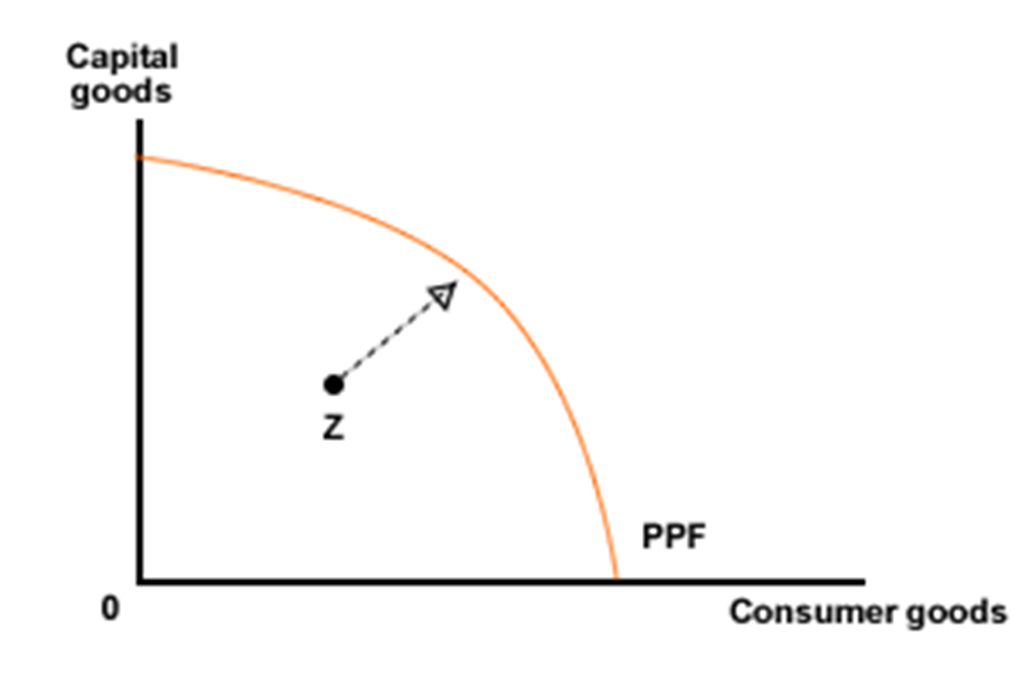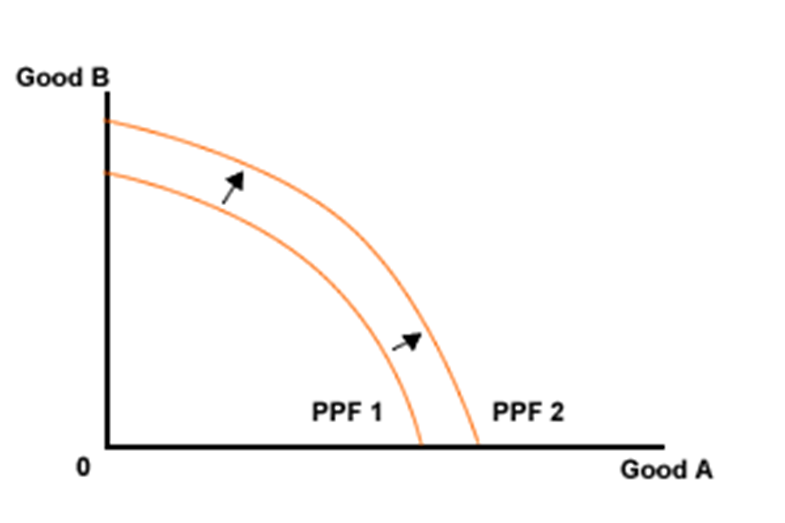Economic Growth
# Economic Growth
Definition - Economic Growth An increase in the capacity of an economy to produce goods and services over time
- The increasing capacity of the economy to satisfy the material wants of its society
# Potential Growth
- The rate of increase in the capacity of the economy to satisfy the needs and wants of people in an economy
# Actual Growth
- The rate of change in real GDP over a given period of time
The target of Australia’s GDP is 3-4%.
# PPFs
# Actual Growth PPF
- If an economy is operating inside its PPF and produces more as a result of using preciously unemployed resources, or using resources more efficiently - referred to as actual growth
- This is illustrated by a movement from a point within the PPF to a point towards or on the PPF

# Potential Growth PPF
- The productive potential of an economy may be increased by an increase in the quality and/or quantity of resources - known as potential growth
- This is illustrated by an outward shift of the PPF

# Measuring Economic Growth
Definition - GDP The total market value of all final goods and services produced in a country during a certain time period
# Calculation
$$\frac{GDP_{yr2}\space - GDP_{yr1}}{GDP_{yr1}}*100$$ NB: Years can be replaced with quarters
# Refining GDP
Nominal GDP:
- The value of output expressed in the prices of the day Real GDP:
- The value of GDP after taking into account the value of inflation
- Real GDP (%) = Nominal GDP (%) - Inflation rate (%)
Real GDP per capita:
- Average real GDP per person in the population
# Limitations of GDP
- Doesn’t describe income distribution
- Coincident Indicator
- Non-market production
- Ignores externalities
- Doesn’t detail whether the growth is sustainable
- Does not describe non-material welfare
# Determinants of Economic Growth
Growth can come from:
- Potential Growth:
- Those that increase the capacity of the economy to produce more goods and services with available resources (supply side)
- Actual Growth:
- How much expenditure is taking place to consume those goods and services (demand side)
# Potential Growth
# Population Growth
- Increase the total size of the economy: greater demand for G+S and productive factors
- Increase in size of labour force: migration and natural increase
- Migration has more growth than natural: migration promotes transfer of wealth, knowledge and skills and positive fiscal impact
# Labour Force Participation
- Proportion of people over 15 years old who are in paid work or actively looking for work
- Higher involvement at work: increases the capacity of production (overcomes the effects of an aging workforce)
- Sustains government tax revenue
# Rising Labour Productivity
- Is the amount of output produced per hour worked
# Capital deepening
- Increase in the stock of capital relative to the stock of other productive resources
- Production becomes more capital intensive: increasing labour productivity
- Technology changes and improvements of function which help to increase the amount of output
# Multi-Factor Productivity
- All other factors that improve a worker’s ability to produce goods and services (not capita)
- Knowledge and skills that workers develop through education and experience
# Actual Growth
- Factors that affect spending in the economy:
- Consumption
- Investment
- Government expenditure
- Net exports
# Cost/Benefits
# Benefits of Economic Growth
Increased material standard of living
- Increased quantity of goods and services
- Satisfy more wants and needs
Increased Level of REAL INCOME
- How much money an individual or entity makes after accounting for inflation
Reduced Unemployment
- Growth stimulates demand for labour, which means more people will be employed and less unemployment
Improved Efficiency
- Promote knowledge, skills, productivity and tech changes
Fiscal Dividend
- Rising income will lead to higher taxation revenue which can be used for public and merit goods such as infrastructure, health, etc
- Public and merit goods generate considerable external benefits
- More hospitals and schools mean a healthier and better-educated population
# Costs of Economic Growth
Structural Unemployment
- From structural change:
- When people want new type of G+S and when inventions make it possible?
Inflationary Pressure
- When resources are fully employed and the economy is working near its capacity
- High inflation
Environmental Degradation
- As production and consumption increase, negative externalities (pollution, etc) are likely to arise
Social Dislocation
- High rates of growth may lead to crimes, stress related diseases, suicide, etc
Income Inequality
- May not raise standards of living of everyone in the economy at the same rate